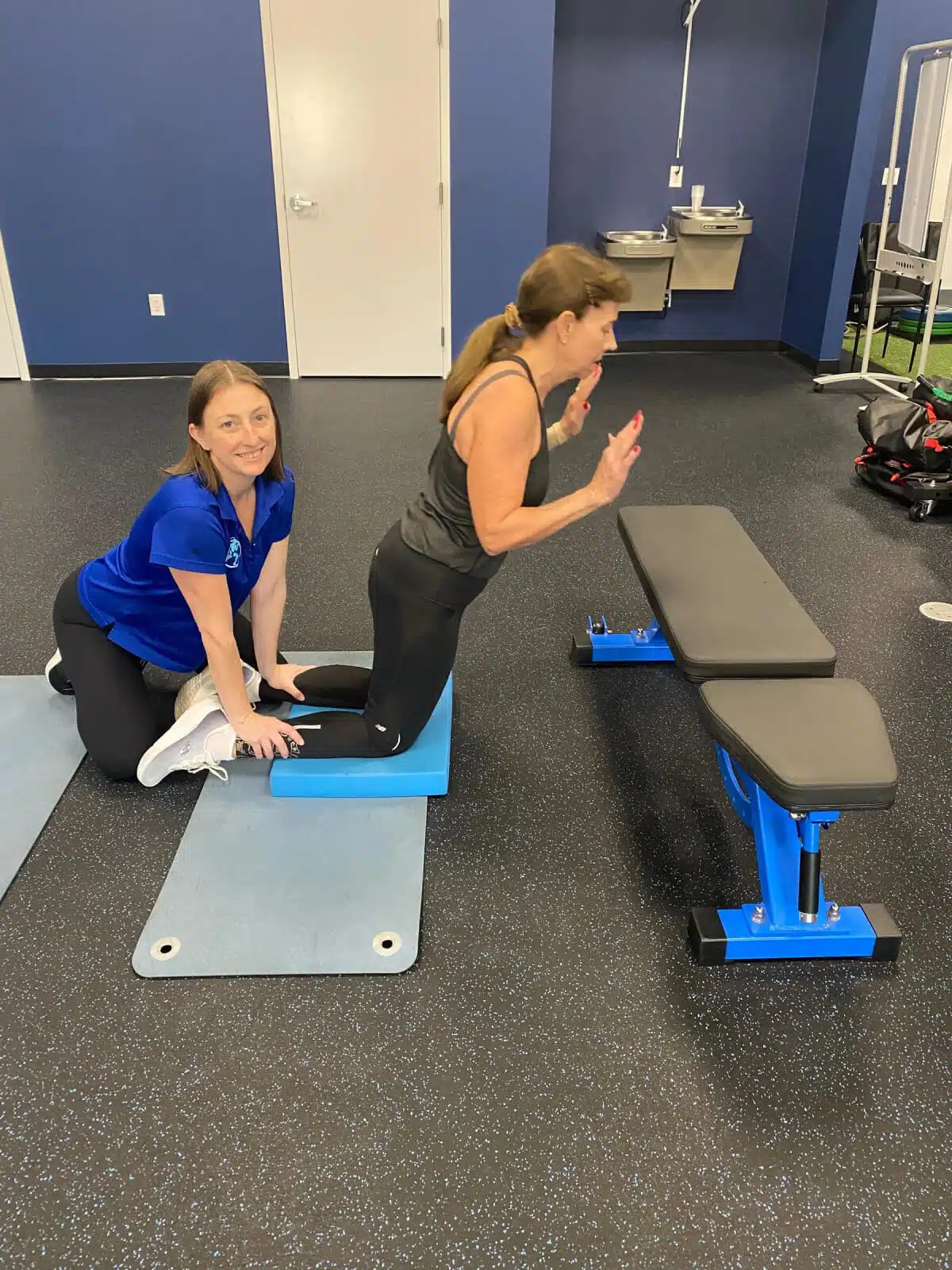How to Choose a Personal Trainer (That Actually Fits Your 50+ Body)
If you’ve ever walked into a gym, looked around at the sea of machines and “miracle programs,” and thought, Where on earth do I start?—you’re not alone. Picking the right personal trainer matters more than most people think, especially if you’re 50+ and want strength, energy, and confidence without beating up your joints. The right coach helps you fix the cause (not just the symptom), stay safe, and make steady progress you can feel in everyday life—stairs, sleep, golf, grandkids, all of it.
As a Doctor of Physical Therapy and founder of Back In Motion Physical Therapy & Performance, I’ve seen what works—and what doesn’t—thousands of times. Here’s a practical guide to choosing a trainer who fits your goals, your history, and your body now.
1) Start With Safety and Screening
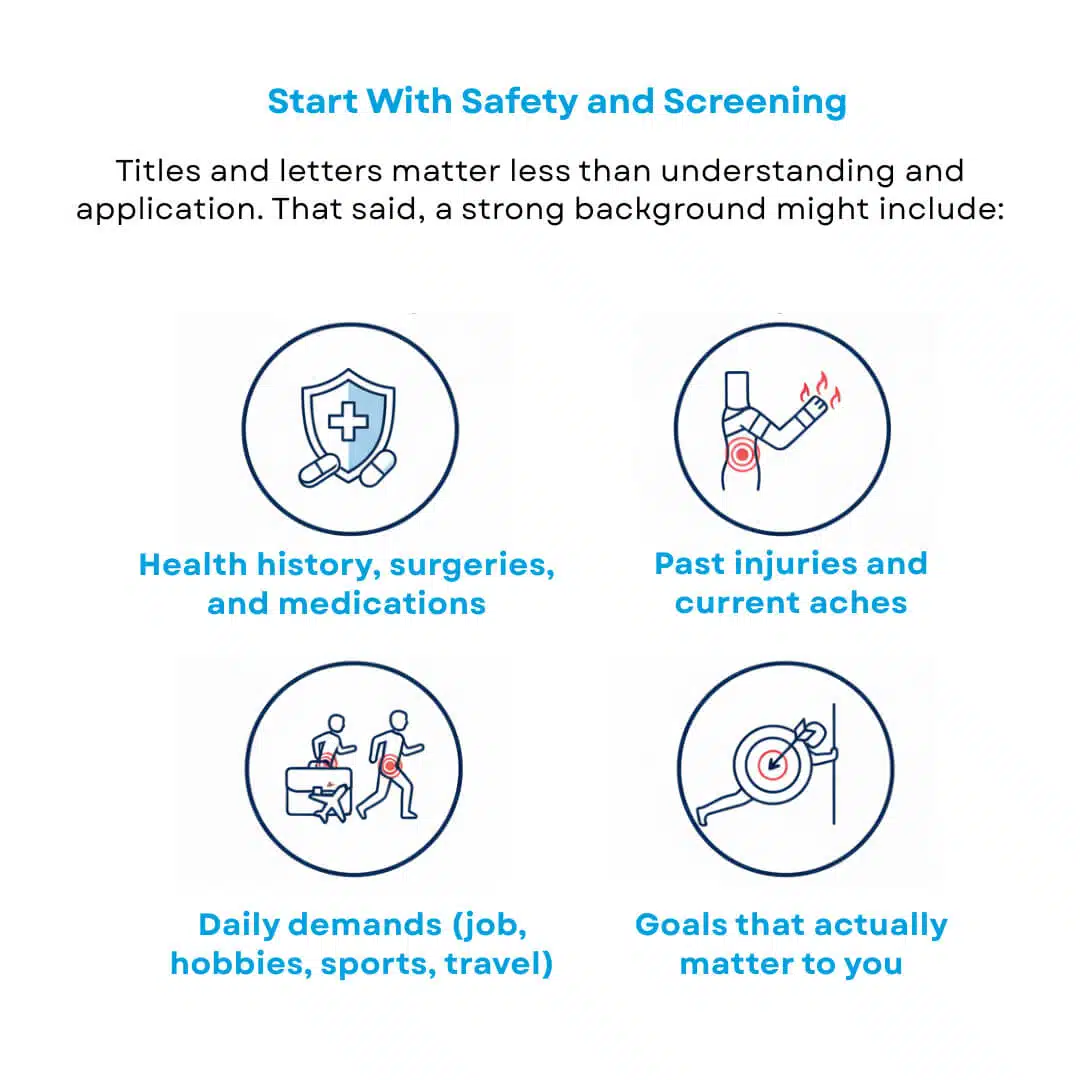
A great trainer begins with a conversation and an assessment, not a workout. Before anyone loads a barbell or turns up the treadmill, they should ask about:
Health history, surgeries, and medications
- Past injuries and current aches
- Daily demands (job, hobbies, sports, travel)
- Goals that actually matter to you
Then, they should screen how you move—hips, core, posture, balance, and breathing/pressure mechanics. If your trainer isn’t curious about how your body moves or what flares you up, they’re guessing. Guessing is how people get hurt or stall out.
Pro tip: Ask what they do when something hurts mid-session. The right answer includes modifying the exercise, finding pain-free alternatives, and protecting progress—not “push through it.”
2) Look for Real Expertise (Not Just Hype)
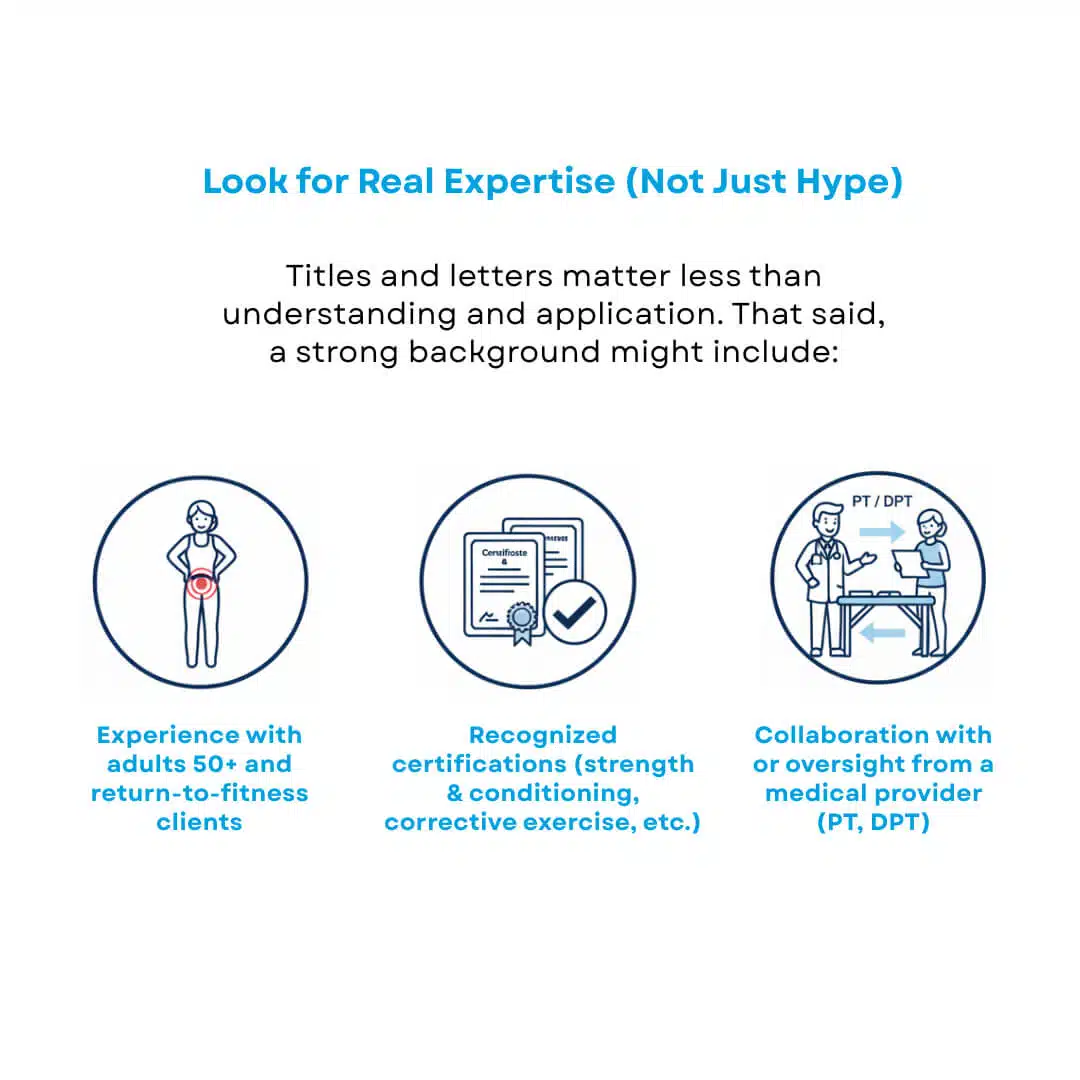
Titles and letters matter less than understanding and application. That said, a strong background might include:
Experience with adults 50+ and return-to-fitness clients
- Recognized certifications (strength & conditioning, corrective exercise, etc.)
- Collaboration with or oversight from a medical provider (PT, DPT)
At Back In Motion, for example, our personal training is designed and coached with medical-meets-performance insight. That means every plan respects your joints while you rebuild strength, mobility, and energy.
3) Programs Should Be Personalized (and Joint-Friendly)
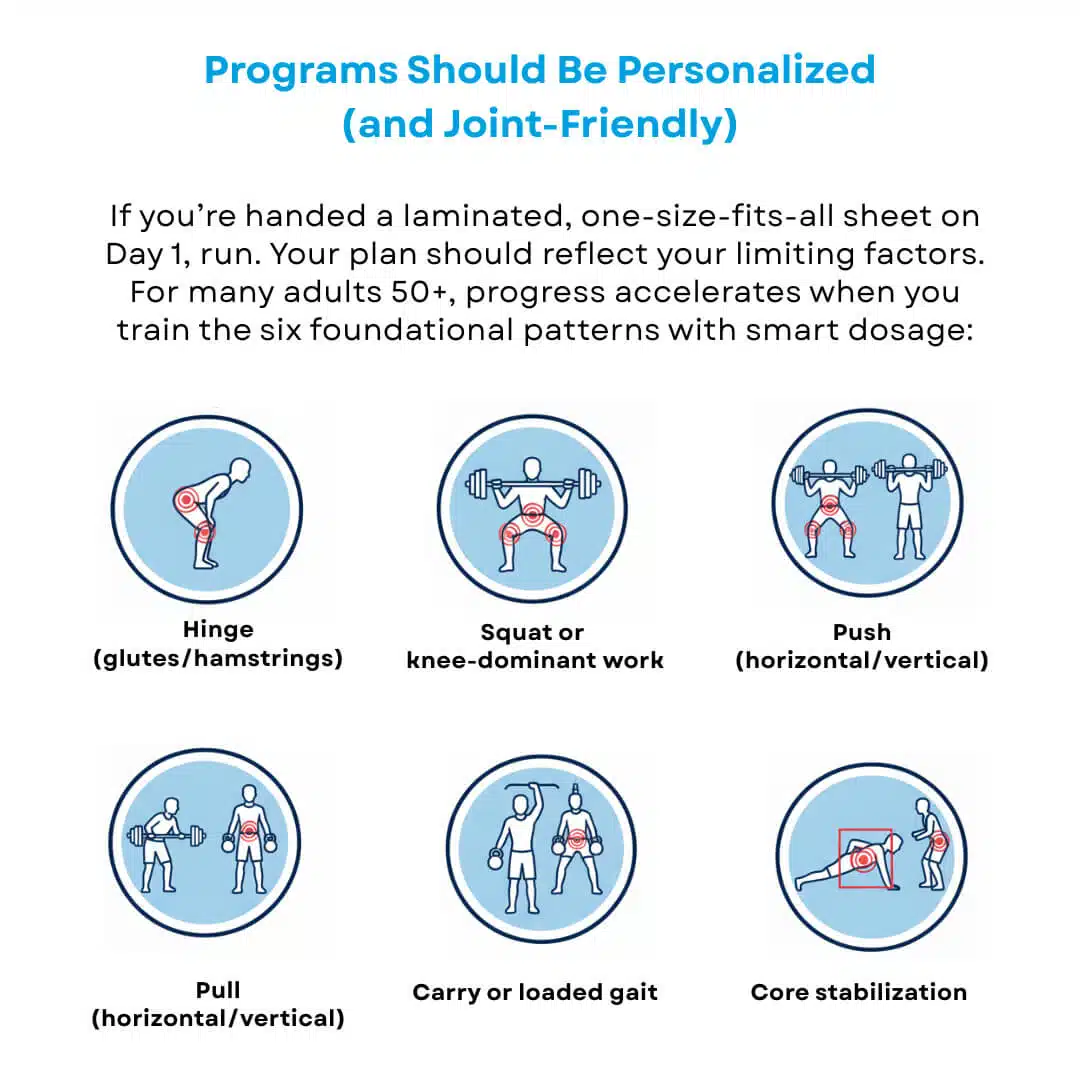
If you’re handed a laminated, one-size-fits-all sheet on Day 1, run. Your plan should reflect your limiting factors. For many adults 50+, progress accelerates when you train the six foundational patterns with smart dosage:
Hinge (glutes/hamstrings)
- Squat or knee-dominant work
- Push (horizontal/vertical)
- Pull (horizontal/vertical)
- Carry or loaded gait
- Core stabilization (anti-extension, anti-rotation, anti-lateral flexion)
Great programs use progressive overload (increase one variable at a time), tempo and range you can control, and deload weeks to let tissues adapt. Sessions should leave you feeling better, not wiped for two days.
4) Coaching Style Matters as Much as the Plan
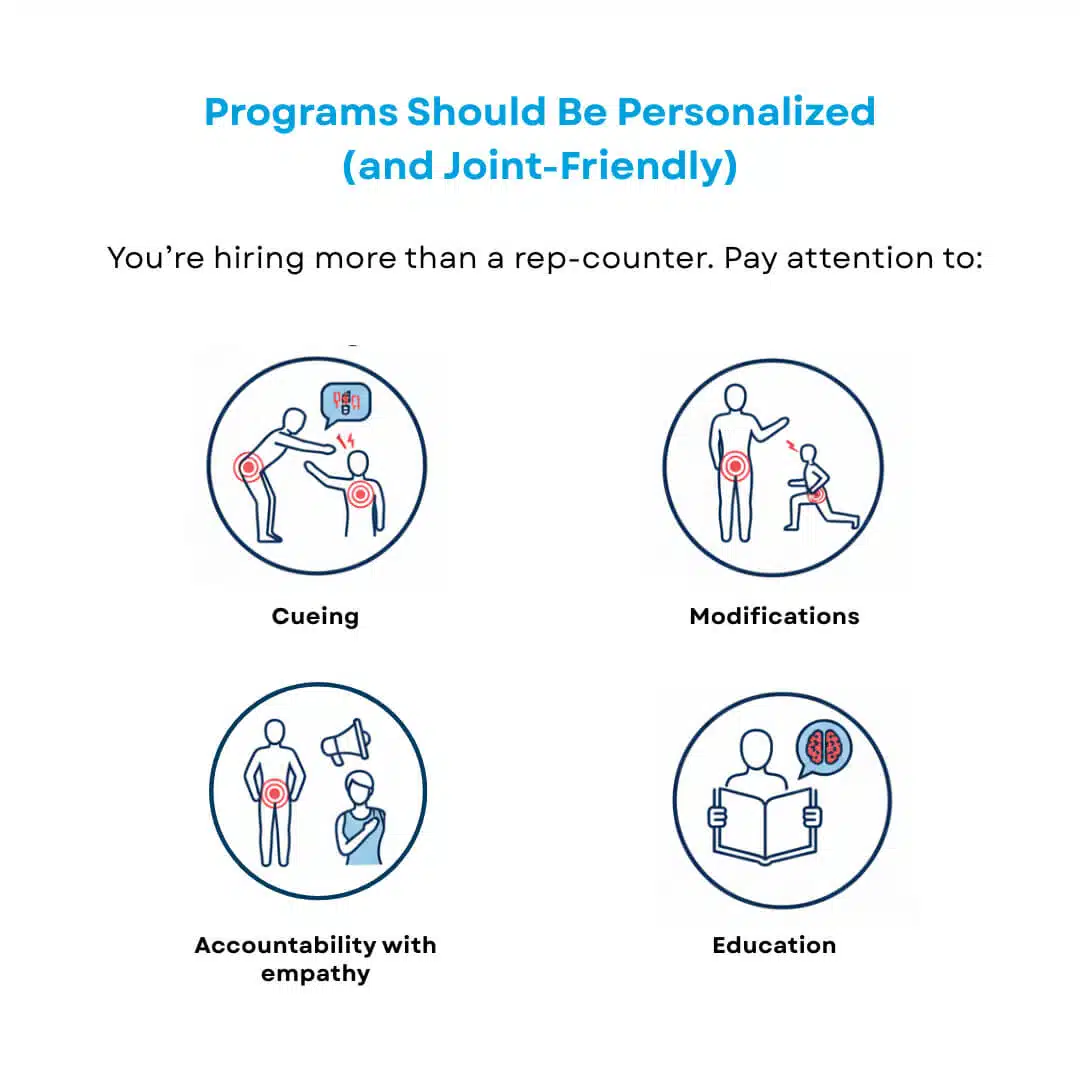
You’re hiring more than a rep-counter. Pay attention to:
- Cueing: Can they explain an exercise in simple terms and help you feel it in the right places?
- Modifications: Do they have three ways to achieve the same goal if X bothers your knee/back/shoulder?
- Accountability with empathy: The best coaches balance encouragement and realism.
- Education: You should learn why you’re doing something, not just what to do.
If you leave a session confused, you didn’t get coached—you got supervised.
5) Red Flags to Avoid
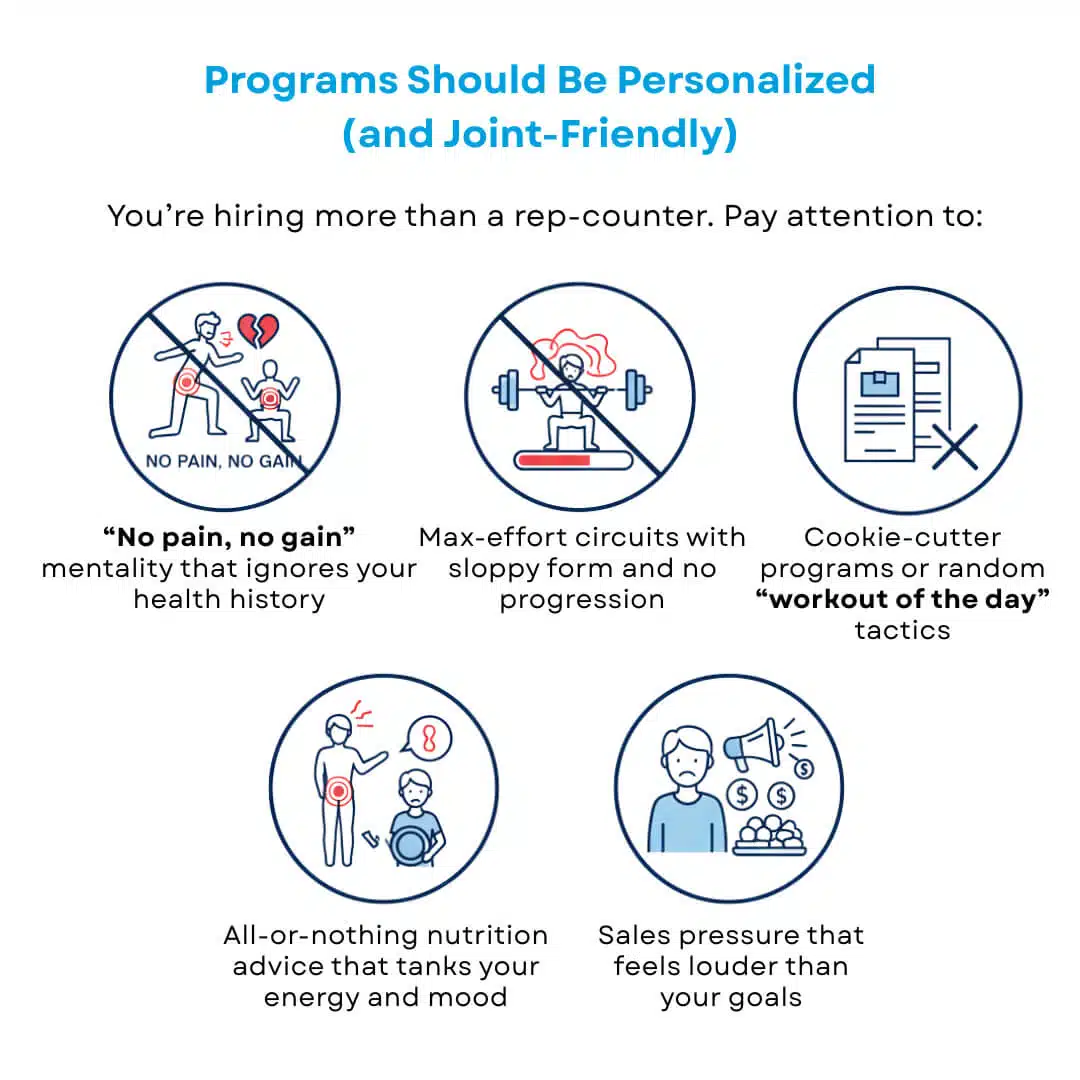
- “No pain, no gain” mentality that ignores your health history
- Max-effort circuits with sloppy form and no progression
- Cookie-cutter programs or random “workout of the day” tactics
- All-or-nothing nutrition advice that tanks your energy and mood
- Sales pressure that feels louder than your goals
Your trainer should earn trust by solving problems, not by turning up the music.
6) Questions to Ask Before You Start
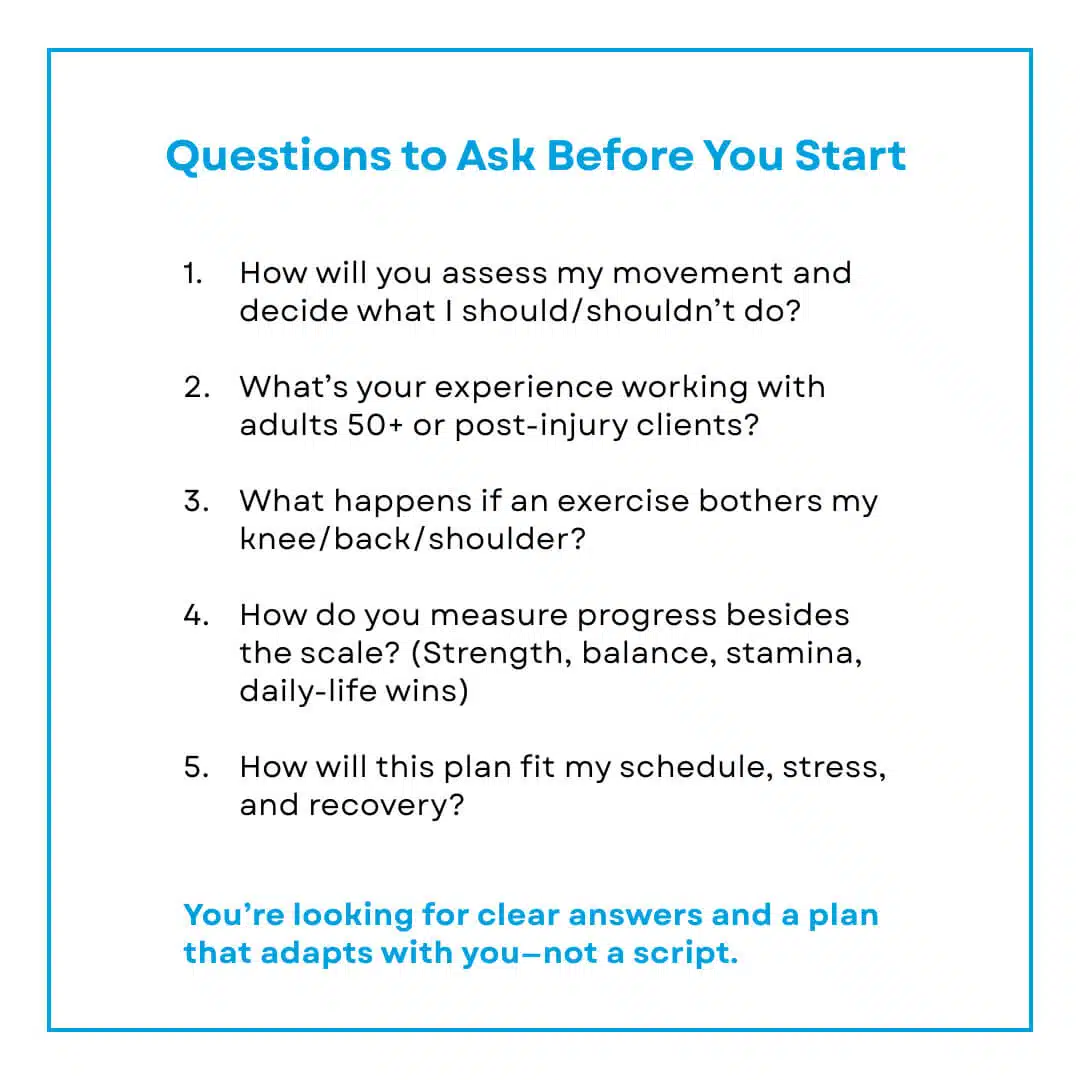
- How will you assess my movement and decide what I should/shouldn’t do?
- What’s your experience working with adults 50+ or post-injury clients?
- What happens if an exercise bothers my knee/back/shoulder?
- How do you measure progress besides the scale? (Strength, balance, stamina, daily-life wins)
- How will this plan fit my schedule, stress, and recovery?
You’re looking for clear answers and a plan that adapts with you—not a script.
7) Value, Frequency, and Results
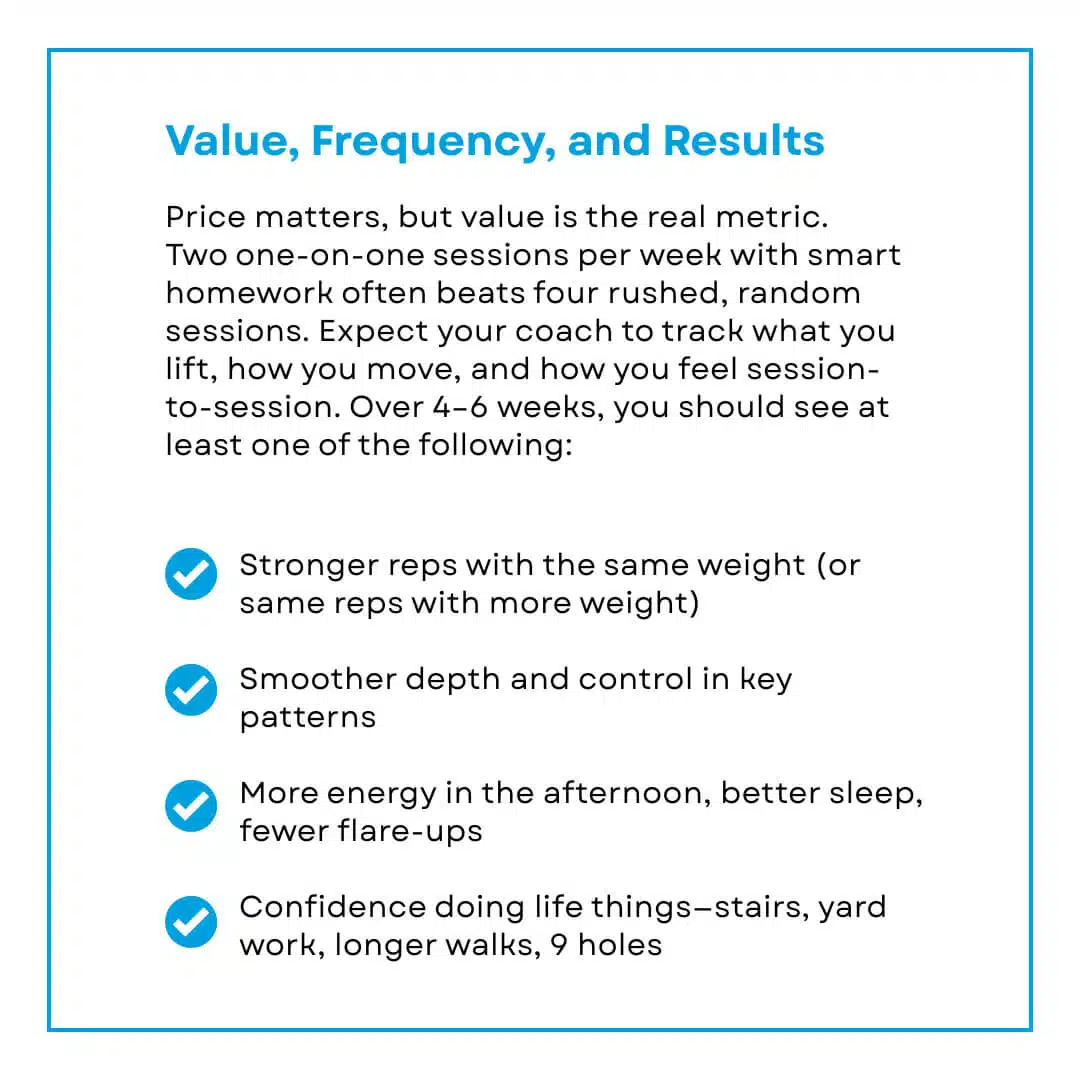
Price matters, but value is the real metric. Two one-on-one sessions per week with smart homework often beats four rushed, random sessions. Expect your coach to track what you lift, how you move, and how you feel session-to-session. Over 4–6 weeks, you should see at least one of the following:
Stronger reps with the same weight (or same reps with more weight)
- Smoother depth and control in key patterns
- More energy in the afternoon, better sleep, fewer flare-ups
- Confidence doing life things—stairs, yard work, longer walks, 9 holes
8) Why Our Approach Works (and Lasts)
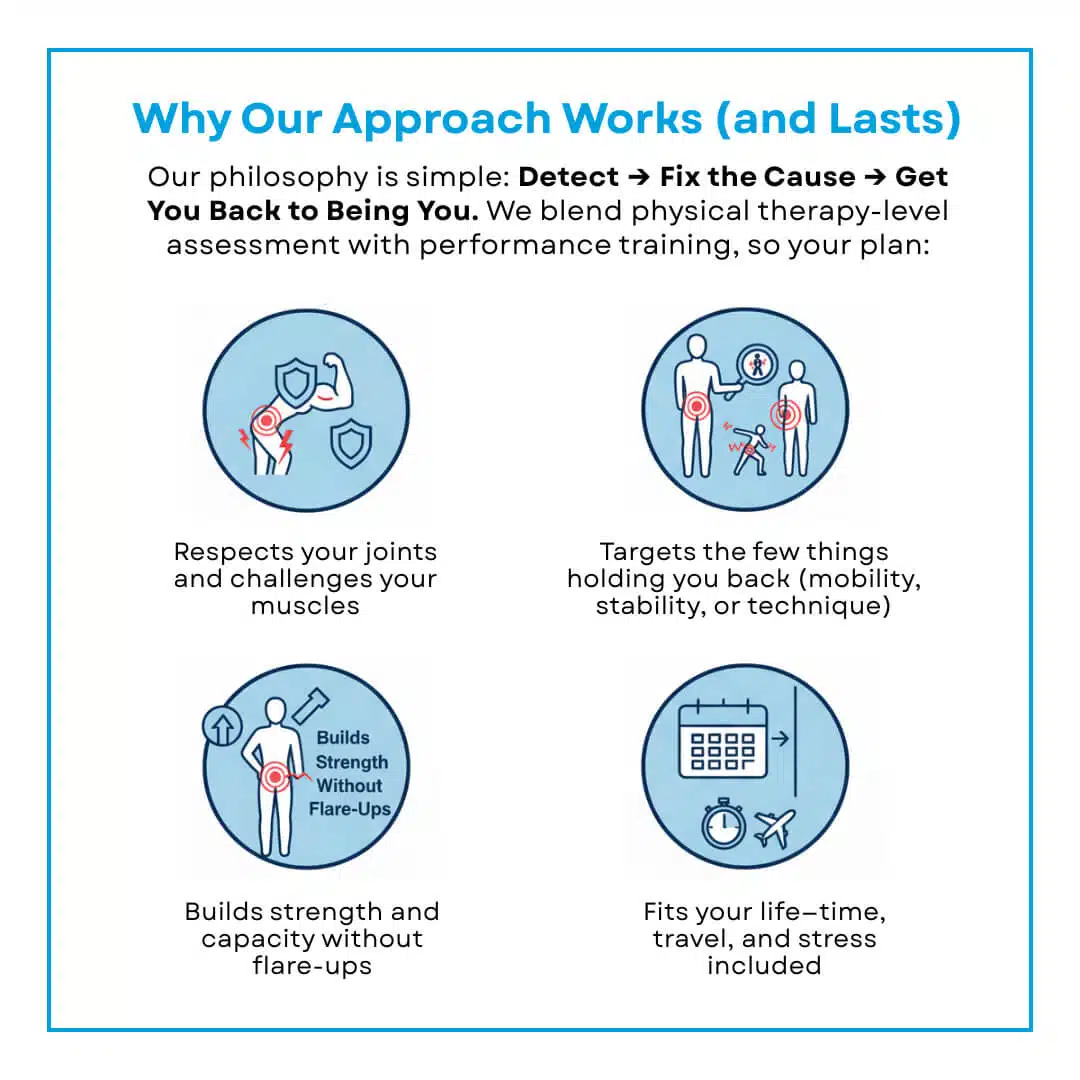
Our philosophy is simple: Detect → Fix the Cause → Get You Back to Being You. We blend physical therapy-level assessment with performance training, so your plan:
- Respects your joints and challenges your muscles
- Targets the few things holding you back (mobility, stability, or technique)
- Builds strength and capacity without flare-ups
- Fits your life—time, travel, and stress included
If you want a team that understands 50+ bodies and coaches every rep for safety and progress, we’d love to help.
For details on our programs, visit our internal page: Personal trainer fort myers.
9) Try Before You Commit: The Fit After 50 Consultation
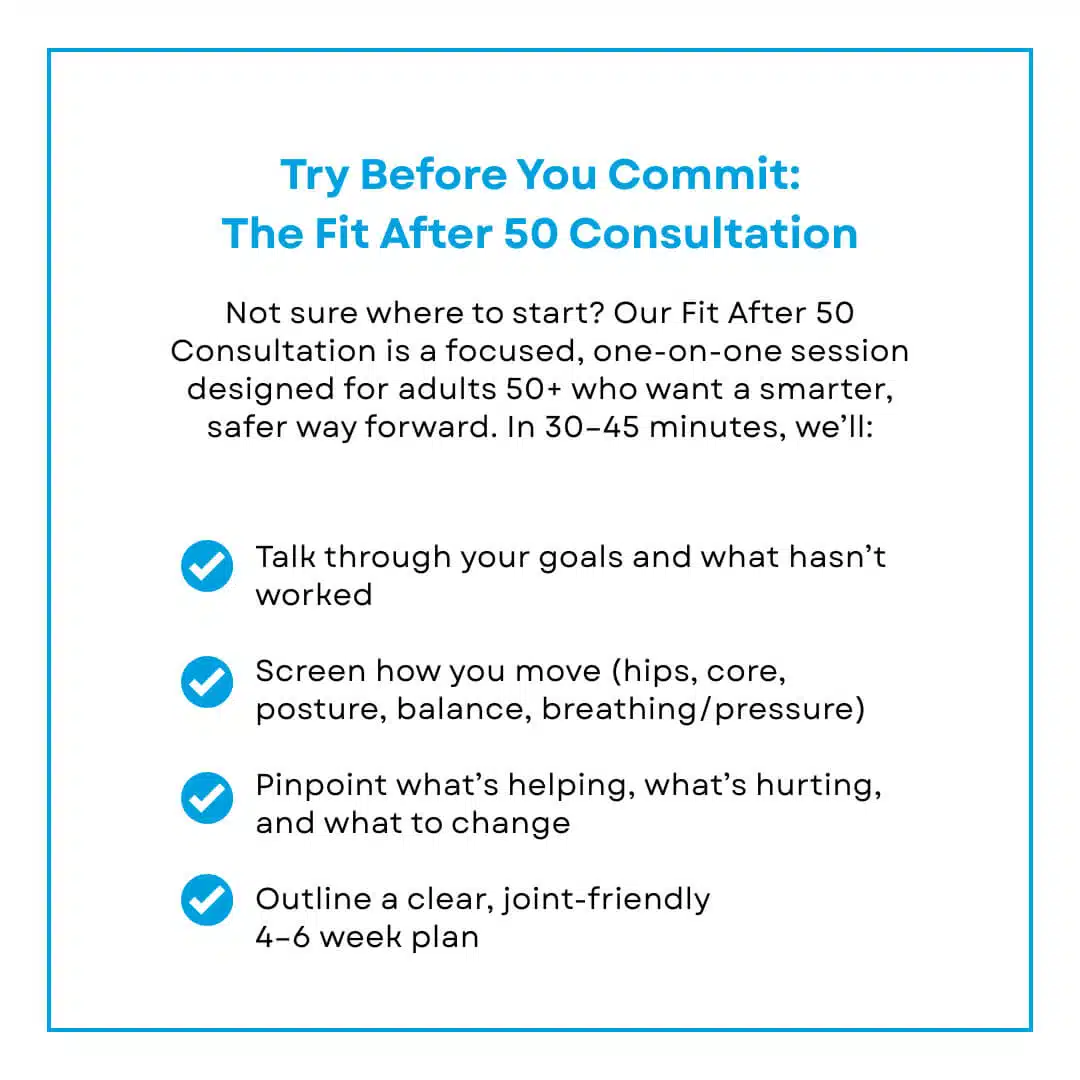
Not sure where to start? Our Fit After 50 Consultation is a focused, one-on-one session designed for adults 50+ who want a smarter, safer way forward. In 30–45 minutes, we’ll:
- Talk through your goals and what hasn’t worked
- Screen how you move (hips, core, posture, balance, breathing/pressure)
- Pinpoint what’s helping, what’s hurting, and what to change
- Outline a clear, joint-friendly 4–6 week plan
No pressure. No boot-camp theatrics. Just clarity and a path that fits your body now.
The Bottom Line
Choosing a personal trainer isn’t about finding the loudest class or the fanciest machine. It’s about finding a professional problem-solver who sees you—your goals, your history, your joints—and builds a plan that helps you feel better today and stronger tomorrow. When you focus on screening, personalization, coaching quality, and steady progression, results don’t just happen—they stick.
Ready to feel more like yourself again? Start with a plan, not guesswork. Learn more about how we coach on our personal training Fort Myers page, or call us to schedule your consultation. Let’s build strength, energy, and confidence the right way—safely, sustainably, and on your terms.

